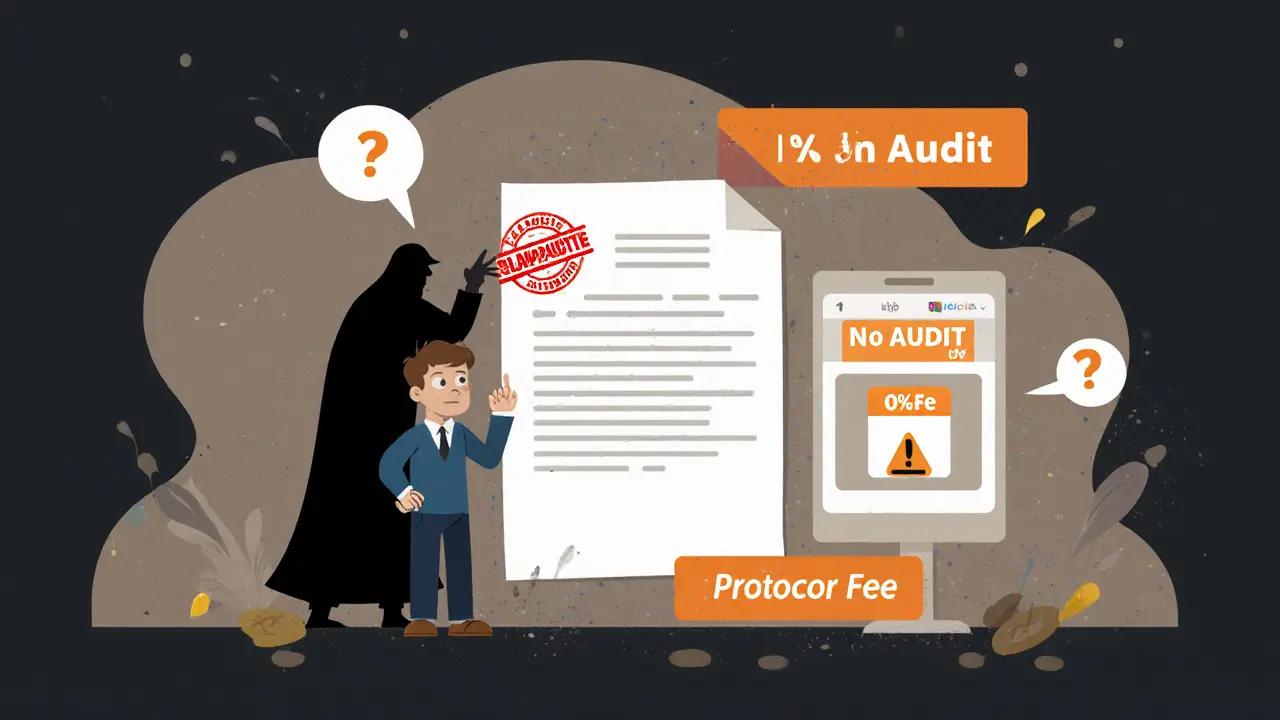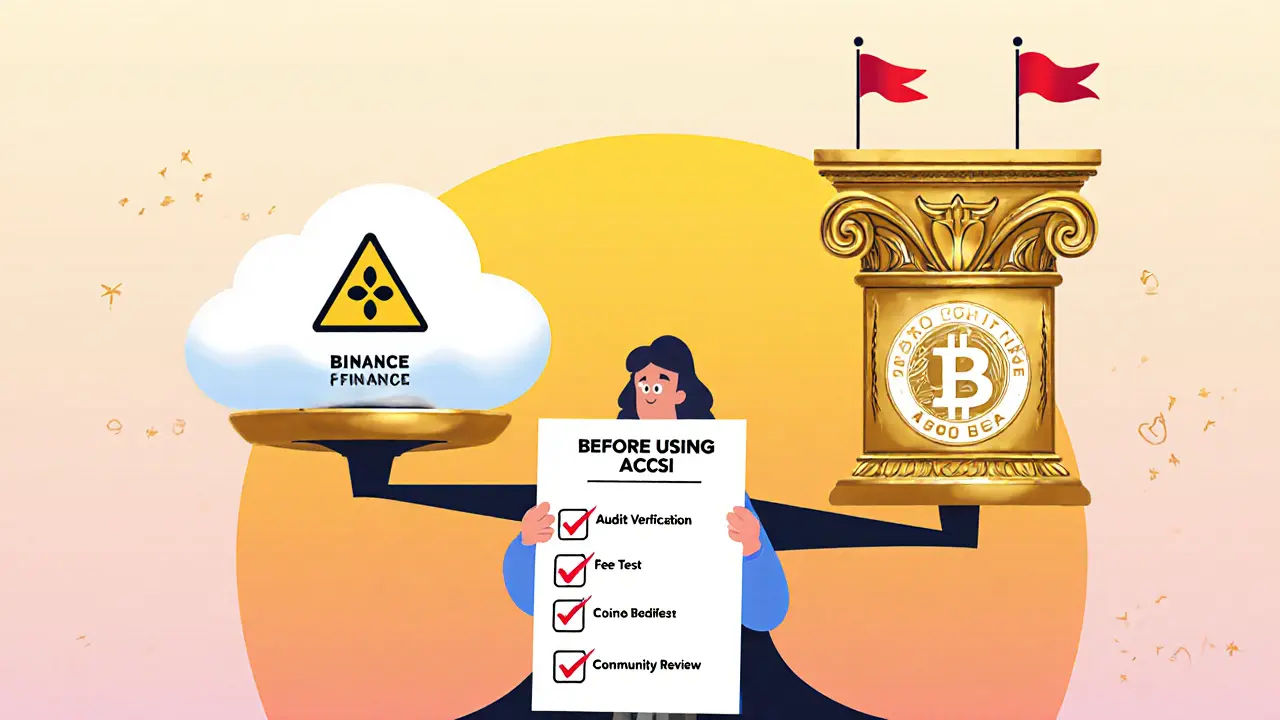ACSI Finance Review: Is This DeFi Exchange Worth Your Crypto?

DeFi Audit & Security Checker
DeFi Security Check
This tool helps you verify if a DeFi platform's smart contracts are properly verified on Etherscan and if security audits have been conducted. Based on the article's findings about ACSI Finance, it's critical to check these factors before engaging with any DeFi platform.
Why This Matters
According to the article, ACSI Finance has no public audit reports, which is a major red flag in the DeFi space. Security audits by reputable firms like Quantstamp, CertiK, or PeckShield are essential because they help identify vulnerabilities in smart contracts.
Additionally, contract verification on Etherscan ensures that the code deployed on the blockchain matches what was written by the developers. Without verification, you're essentially trusting unverified code, which can lead to potential exploits.
Always verify a platform's security before depositing any funds.
When you hear the name ACSI Finance is described as a DeFi hub that lets users stake, swap tokens, and lock assets in yield vaults. It’s powered by ACryptoS, a development studio that claims to focus on decentralized finance solutions. The platform markets itself as a one‑stop shop for crypto enthusiasts who want to earn rewards without leaving the ecosystem.
Key Takeaways
- ACSI Finance offers staking, token swapping, and yield vaults, but details are sparse.
- No public audit reports have been released, raising security concerns.
- Fee schedules are hidden; users may face unpredictable costs.
- Compared to established exchanges like Binance or Coinbase, transparency is a major missing piece.
- Proceed with caution and consider a well‑known, audited platform first.
What Is ACSI Finance?
In plain terms, ACSI Finance is a decentralized finance (DeFi) platform that tries to combine three popular services:
- Staking - lock up supported tokens to earn periodic rewards.
- Token swapping - exchange one cryptocurrency for another directly on the platform.
- Yield vaults - pool assets into smart contracts that aim to generate higher returns.
The site’s UI is clean, with a dark theme that feels similar to other modern wallets. You don’t need to create a traditional account; you simply connect a Web3 wallet (MetaMask, Trust Wallet, etc.) and start interacting.
Core Services Explained
Staking on ACSI Finance works like most DeFi protocols: you deposit a supported token, the smart contract locks it, and you receive reward tokens that are distributed each epoch. The exact APY (annual percentage yield) is shown on the dashboard, but the calculation method isn’t disclosed.
Token swapping uses an internal liquidity pool rather than external order books. The swap interface looks similar to Uniswap, with slippage controls and a price impact meter. However, the platform does not publish the depth of its liquidity pools, making it hard to gauge how large trades would be affected.
Yield vaults are the most opaque feature. You deposit assets, and the protocol claims to run automated strategies (e.g., lending, arbitrage) to boost returns. No third‑party audit reports are linked, and the vaults’ smart‑contract addresses are not verified on major explorers.
Security & Audit Concerns
Security is the number one deal‑breaker for any DeFi platform. ACSI Finance’s website does not display any audit certificates, and a quick search on reputable auditors (Quantstamp, CertiK, PeckShield) returns no results. In the DeFi world, an audit is a baseline signal that independent experts have examined the code for vulnerabilities.
Without a published audit, users are forced to trust the code “as is.” That trust is further weakened by the fact that the platform’s smart‑contract addresses are often hidden behind a proxy, making on‑chain verification difficult. If you’re comfortable reading Solidity, you can still explore the contracts on Etherscan, but the lack of verification means you’ll see generic bytecode instead of readable source.

Fee Structure & Transparency
Fees are another area where ACSI Finance stays quiet. The obvious fees on most exchanges are:
- Trading or swap fees (usually a percentage of the transaction amount).
- Withdrawal fees (network‑level costs plus platform markup).
- Staking or vault performance fees (a cut of the earned rewards).
ACSI Finance lists a “0% trading fee” banner on its homepage, but the small print mentions a “protocol fee” that is only revealed after the swap is executed. Withdrawal fees are shown as “network gas” without indicating any additional platform charge. This lack of upfront disclosure makes it risky for users to estimate the real cost of moving funds.
User Experience & Support
From a UI perspective, the platform feels responsive on both desktop and mobile browsers. The onboarding flow is straightforward: connect wallet, pick a service, confirm the transaction. However, the support options are limited to a Telegram channel and a generic “Contact Us” form that redirects to a blank page. No live chat, knowledge base, or SLA is mentioned.
When you search community forums (Reddit, Bitcointalk), you’ll find a handful of posts asking about withdrawal delays and vague fee explanations. Some users report that the Telegram admins are slow to respond, which is a red flag for any service handling real money.
How It Stacks Up Against Major Exchanges
| Feature | ACSI Finance | Binance | Coinbase |
|---|---|---|---|
| Regulation & Licensing | None disclosed | Licensed in multiple jurisdictions | US‑registered, regulated |
| Audit Status | No public audit | Regular third‑party audits | Annual SOC 2 audit |
| Fee Transparency | Hidden protocol fees | 0.1%‑0.2% maker/taker | 0.5% spread + fixed fee |
| Supported Tokens | Limited, mainly ERC‑20 | Thousands across many chains | Hundreds, major assets |
| Customer Support | Telegram only, slow | 24/7 live chat, email | Phone, chat, email |
As the table shows, ACSI Finance falls short on regulation, security audits, and fee clarity. If you value those pillars, a mainstream exchange is a safer bet.

Red Flags & Who Should Avoid
Based on the research, here are the biggest warning signs:
- No verifiable audit - increases risk of smart‑contract bugs.
- Opaque fee model - you might pay more than expected.
- Limited support - delays can cost you if something goes wrong.
- Small token list - reduces liquidity for many assets.
- Scam watchlists mention the name - worth a double‑check.
If you’re a casual holder looking for a safe place to store or trade crypto, steer clear. Advanced users who enjoy high‑risk experiments may still try a tiny amount, but only after testing the platform with a few dollars first.
Practical Checklist Before Using ACSI Finance
- Verify the smart‑contract addresses on Etherscan and look for source‑code verification.
- Search for an independent security audit; if none exists, treat the platform as unaudited.
- Test with a small amount (<$50) to gauge actual fees and transaction speed.
- Read the community feedback on Reddit, Twitter, and Telegram - note response times.
- Keep an emergency exit plan: have your assets also stored in a reputable wallet or exchange.
Following these steps can help you avoid costly surprises.
Frequently Asked Questions
Is ACSI Finance a regulated exchange?
No public licensing or regulatory filings have been disclosed, so it should be considered unregulated.
Can I trust the smart contracts on ACSI Finance?
Without a third‑party audit, the contracts carry higher risk. Check the source code yourself or limit exposure.
How are fees calculated for token swaps?
The platform shows a “0% fee” banner, but a hidden protocol fee is applied at settlement. Exact rates are only visible after the swap is executed.
What assets can I stake on ACSI Finance?
Currently only a handful of ERC‑20 tokens are supported. The list is displayed on the staking page and may change without notice.
Is there a mobile app for ACSI Finance?
No dedicated app yet; the web UI is mobile‑responsive and works through a browser wallet extension.


Prabhleen Bhatti
Hey folks, diving into ACSI Finance feels like stepping into a quasi‑metaverse of DeFi where staking, swapping, and vaults converge-yeah, the buzzwords are all there, but the devil’s in the details; the platform touts “zero‑fee swaps” yet hides the protocol fee behind a pop‑up after the transaction, which is a classic opacity flag. From a cultural‑ambassador standpoint, I always advocate for community‑driven transparency, so the lack of a public audit is a red flag that can’t be ignored. The UI’s sleek dark mode is aesthetically pleasing, but aesthetic appeal doesn’t substitute for code auditability-remember, even the prettiest façade can conceal vulnerabilities. If you’re curious, run a test transaction with dust‑size crypto first; it’s the safest way to gauge hidden slippage and gas‑price dynamics.
Elizabeth Mitchell
Totally get it, the UI does look slick, but the hidden fees make me pause-sometimes less is more, especially when you can’t see what you’re paying.
Chris Houser
Exactly, start small and watch the numbers. If the rewards look too good to be true, they probably are. Keep an eye on the contract address and compare it on Etherscan-verified code is a good sign.
William Burns
One must consider the epistemological foundations of such platforms; the absence of a third‑party audit fundamentally undermines the ontological certainty required for fiduciary trust. In scholarly terms, the protocol operates in a vacuum of verification, rendering any purported yield mathematically suspect.
Ashley Cecil
Ethical investing demands verifiable security, not speculative allure.
John E Owren
From a coaching perspective, it’s wise to treat ACSI like a sandbox: allocate only what you can afford to lose and treat any gains as a bonus rather than a guarantee.